Post by blacky on Feb 7, 2010 8:49:14 GMT 10
Great White Pyramid
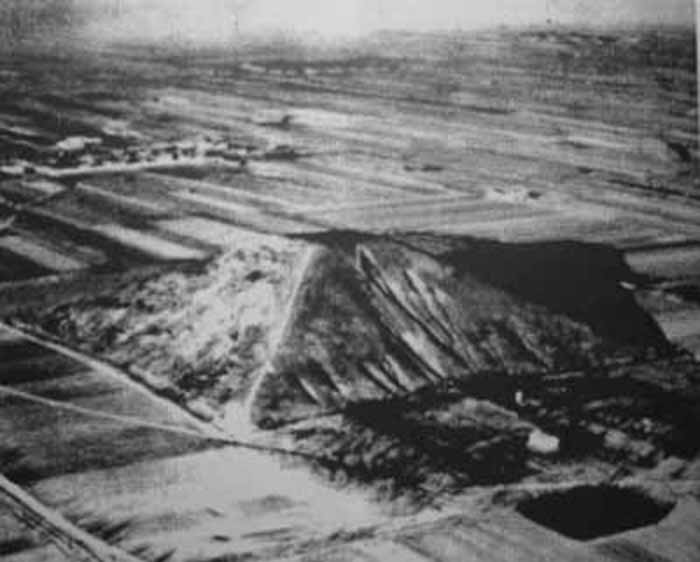
The pyramids of China are approximately 100 ancient mounds, many of which were used for burial. Most of them are located within 100 kilometers of the city of Xi'an, on the Qin Chuan Plains in the Shaanxi Province, central China.
The existence of pyramids in China has come in two stages. Most early stories were focused on the existence of "Great White Pyramid." A photograph of this pyramid in the Qinling mountains was taken by Americans in 1945, but remained in military files for 45 years. US Air Force pilot James Gaussman is said to have seen a white jewel-topped pyramid during a flight between India and China during World War II, but there is scant evidence for a source on this story.
However, it is now believed that the Gaussman story was actually based on Colonel Maurice Sheahan, Far Eastern director of Trans World Airlines, who told an eyewitness account of his encounter with a pyramid in the March 28, 1947 edition of The New York Times. A photo of Sheahan's pyramid appeared in The New York Sunday News on March 30, 1947. It is this photograph that later became attributed to James Gaussman.
t is now known, thanks to efforts of Chris Maier, that the particular pyramid shown in the photo is the Maoling Mausoleum. This pyramid sits just outside of Xi'an. In 1994, German tour operator and author Hartwig Hausdorf was noted for photographing and studying several pyramids.
He drew attention to the structures' existence with his 1994 book Die Weisse Pyramide, the subject of an article in Nexus Magazine in 1995 by Philip Coppens, later translated into English under the revised title The Chinese Roswell (1998).
The pyramids of Xi'an can now be visited on trips from Xi'an and no longer are located in "forbidden zones". Several pyramids have small museums attached to them.
The Great White Pyramid itself (rather than the photograph), as described by Sheahan, remains unidentified.
List of Chinese pyramids
Inner Mongolian pyramid (1 kilometer north of Sijiazi Town, Aohan County)
Maoling Mausoleum
Pyramid of Gathering (Tibet)
Qin Shi Huang's mausoleum
Zangkunchong
Step Pyramid (Ziban)
The Burma Tibetian Pyramid
The Burma Tibetian Pyramid is called 'The Pyramid of Gathering'. It is allegedly a bright white pyramid that is well preserved in the Buhtan Province. The limestone is still preserved beyond imagination. It supposedly glows under light. This pyramid was spotted by U.S. pilots in China in WWll flying over the hump in Burma. It is mentioned much by an Irish author Mona Rolf. It same size as the Great Pyramid in Egypt.
These images were taken by Hartwig Hausdorf, a Germany researcher.

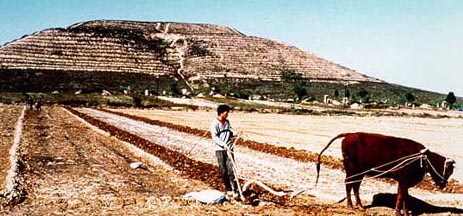


Zangkunchong Step Pyramid
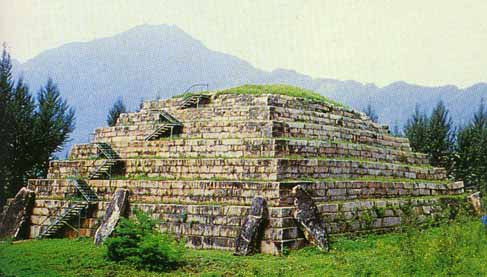
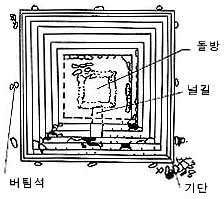
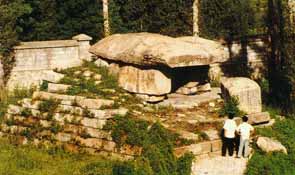
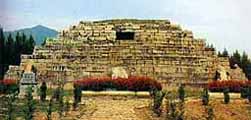
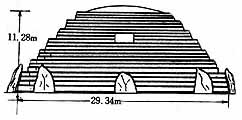
Coffins and ceiling in the inner chamber
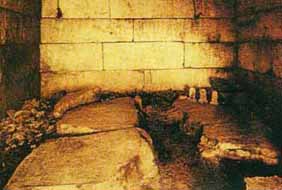
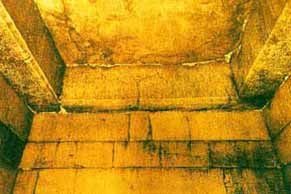
In the News ...
Pyramids in China Google Earth - October 25, 2006
The "White Pyramid" is the Maoling Mausoleum.
3000-year-old "pyramid" discovered in NE China
China View - August 31, 2006
Chinese archaeologists have discovered a group of ancient tombs shaped like pyramids, dating back at least 3,000 years, in Jiaohe City of northeast China's Jilin Province. The tombs, covering an area of 500,000 square meters (1,000 meters long and 500 meters wide), were found after water erosion exposed part of a mountain, revealing two of the tombs. Six smaller tombs had eroded away leaving no indications of their original scale and appearance, but the biggest tomb, located on the south side of the mountain, could clearly be discerned as a pyramid shape with three layers from bottom to top.
The pyramid's square bottom is about 50 meters long and 30 meters wide, about the size of a basketball court, with an oval platform on the top, about 15 meters long and 10 meters wide. The tomb was made of stone and earth dug out from the hill.
A stone coffin, surrounded by four screen boards and covered by a granite top, was placed on the top platform. The coffin appeared to belong to the king of an early tribe based on the dimensions of the site, according to experts with the Jiaohe Archaeological Research Institute. The tombs are part of the Xituanshan cultural ruins site, which dates back 3,000 years to China's Bronze Age period. The ruins were excavated in Jilin in 1950.
A lot of ancient hunting and domestic tools, including a stone knife and axe, as well as bronzeware and earthenware, have been unearthed from the stone coffin and other six smaller graves. The discovery will provide valuable clues on study of ancient funeral customs and the tomb structure and culture of ethnic groups in the area.
Pyramid Built 5000 years ago Found in Inner Mongolia
People's Daily - July 7, 2001
A three-story pyramid dating 5000 years back has been discovered in north China's Inner Mongolia Autonomous Region. The pyramid, which looks like a trapezoidal hill from afar, is located on a hill one kilometer north of Sijiazi Town, Aohan County. The pyramid is about 30 meters long and 15 meters wide at its base. This is considered the best-preserved pyramid built during the Hongshan Culture period that has been found so far, said Guo Dasun, an archaeologist in charge of the excavation.
Seven tombs and one altar were also found on the top of the pyramid. Archaeologists also discovered a number of pottery pieces with the asterisk character inscribed on the inner wall. The asterisk character is believed to be related to the understanding of ancient people on astrology.
Among the culture relics excavated from one of the seven tombs are a bone flute and a stone ring and a full- sized stone statue of Goddess unearthed from another tomb. What astonished the archeologists is a one palm-sized stone genital found on the inner wall of a tomb with a small stone statue of Goddess below. Guo Dasun said that most of these relics are found for the first time and will shed light on studying the origin of Chinese civilization.

The pyramids of China are approximately 100 ancient mounds, many of which were used for burial. Most of them are located within 100 kilometers of the city of Xi'an, on the Qin Chuan Plains in the Shaanxi Province, central China.
The existence of pyramids in China has come in two stages. Most early stories were focused on the existence of "Great White Pyramid." A photograph of this pyramid in the Qinling mountains was taken by Americans in 1945, but remained in military files for 45 years. US Air Force pilot James Gaussman is said to have seen a white jewel-topped pyramid during a flight between India and China during World War II, but there is scant evidence for a source on this story.
However, it is now believed that the Gaussman story was actually based on Colonel Maurice Sheahan, Far Eastern director of Trans World Airlines, who told an eyewitness account of his encounter with a pyramid in the March 28, 1947 edition of The New York Times. A photo of Sheahan's pyramid appeared in The New York Sunday News on March 30, 1947. It is this photograph that later became attributed to James Gaussman.
t is now known, thanks to efforts of Chris Maier, that the particular pyramid shown in the photo is the Maoling Mausoleum. This pyramid sits just outside of Xi'an. In 1994, German tour operator and author Hartwig Hausdorf was noted for photographing and studying several pyramids.
He drew attention to the structures' existence with his 1994 book Die Weisse Pyramide, the subject of an article in Nexus Magazine in 1995 by Philip Coppens, later translated into English under the revised title The Chinese Roswell (1998).
The pyramids of Xi'an can now be visited on trips from Xi'an and no longer are located in "forbidden zones". Several pyramids have small museums attached to them.
The Great White Pyramid itself (rather than the photograph), as described by Sheahan, remains unidentified.
List of Chinese pyramids
Inner Mongolian pyramid (1 kilometer north of Sijiazi Town, Aohan County)
Maoling Mausoleum
Pyramid of Gathering (Tibet)
Qin Shi Huang's mausoleum
Zangkunchong
Step Pyramid (Ziban)
The Burma Tibetian Pyramid
The Burma Tibetian Pyramid is called 'The Pyramid of Gathering'. It is allegedly a bright white pyramid that is well preserved in the Buhtan Province. The limestone is still preserved beyond imagination. It supposedly glows under light. This pyramid was spotted by U.S. pilots in China in WWll flying over the hump in Burma. It is mentioned much by an Irish author Mona Rolf. It same size as the Great Pyramid in Egypt.
These images were taken by Hartwig Hausdorf, a Germany researcher.




Zangkunchong Step Pyramid





Coffins and ceiling in the inner chamber


In the News ...
Pyramids in China Google Earth - October 25, 2006
The "White Pyramid" is the Maoling Mausoleum.
3000-year-old "pyramid" discovered in NE China
China View - August 31, 2006
Chinese archaeologists have discovered a group of ancient tombs shaped like pyramids, dating back at least 3,000 years, in Jiaohe City of northeast China's Jilin Province. The tombs, covering an area of 500,000 square meters (1,000 meters long and 500 meters wide), were found after water erosion exposed part of a mountain, revealing two of the tombs. Six smaller tombs had eroded away leaving no indications of their original scale and appearance, but the biggest tomb, located on the south side of the mountain, could clearly be discerned as a pyramid shape with three layers from bottom to top.
The pyramid's square bottom is about 50 meters long and 30 meters wide, about the size of a basketball court, with an oval platform on the top, about 15 meters long and 10 meters wide. The tomb was made of stone and earth dug out from the hill.
A stone coffin, surrounded by four screen boards and covered by a granite top, was placed on the top platform. The coffin appeared to belong to the king of an early tribe based on the dimensions of the site, according to experts with the Jiaohe Archaeological Research Institute. The tombs are part of the Xituanshan cultural ruins site, which dates back 3,000 years to China's Bronze Age period. The ruins were excavated in Jilin in 1950.
A lot of ancient hunting and domestic tools, including a stone knife and axe, as well as bronzeware and earthenware, have been unearthed from the stone coffin and other six smaller graves. The discovery will provide valuable clues on study of ancient funeral customs and the tomb structure and culture of ethnic groups in the area.
Pyramid Built 5000 years ago Found in Inner Mongolia
People's Daily - July 7, 2001
A three-story pyramid dating 5000 years back has been discovered in north China's Inner Mongolia Autonomous Region. The pyramid, which looks like a trapezoidal hill from afar, is located on a hill one kilometer north of Sijiazi Town, Aohan County. The pyramid is about 30 meters long and 15 meters wide at its base. This is considered the best-preserved pyramid built during the Hongshan Culture period that has been found so far, said Guo Dasun, an archaeologist in charge of the excavation.
Seven tombs and one altar were also found on the top of the pyramid. Archaeologists also discovered a number of pottery pieces with the asterisk character inscribed on the inner wall. The asterisk character is believed to be related to the understanding of ancient people on astrology.
Among the culture relics excavated from one of the seven tombs are a bone flute and a stone ring and a full- sized stone statue of Goddess unearthed from another tomb. What astonished the archeologists is a one palm-sized stone genital found on the inner wall of a tomb with a small stone statue of Goddess below. Guo Dasun said that most of these relics are found for the first time and will shed light on studying the origin of Chinese civilization.
















 Happy New Years Everybody!!!
Happy New Years Everybody!!!
